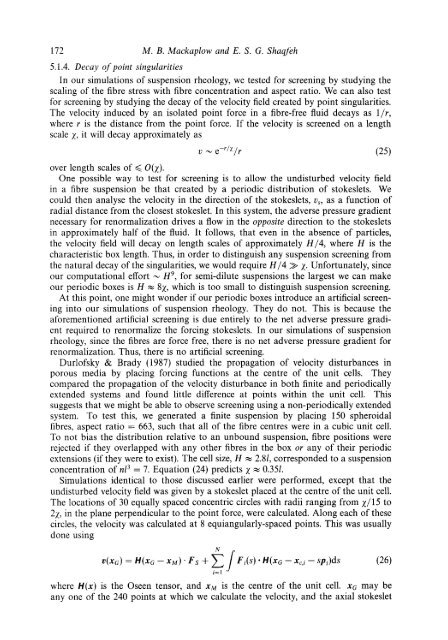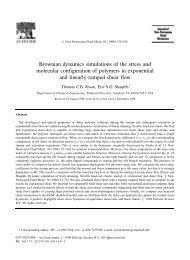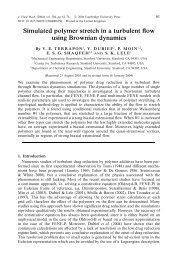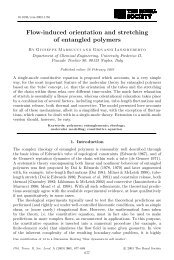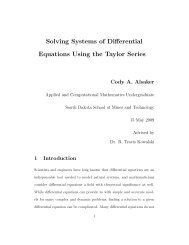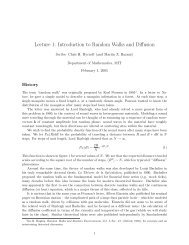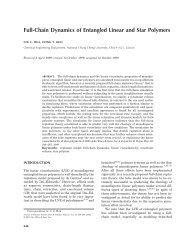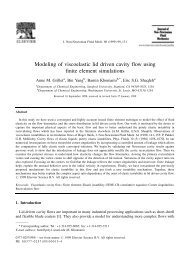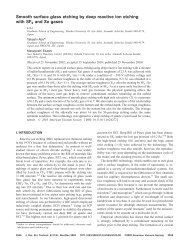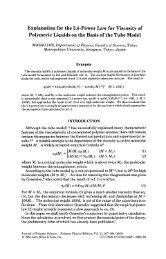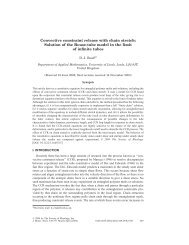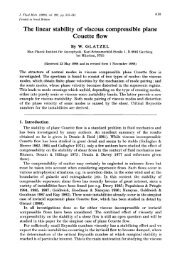A numerical study of the rheological properties of suspensions of ...
A numerical study of the rheological properties of suspensions of ...
A numerical study of the rheological properties of suspensions of ...
Create successful ePaper yourself
Turn your PDF publications into a flip-book with our unique Google optimized e-Paper software.
172M. B. Mackaplow and E. S. G. Shaqfeh5.1.4. Decay <strong>of</strong> point singularitiesIn our simulations <strong>of</strong> suspension rheology, we tested for screening by <strong>study</strong>ing <strong>the</strong>scaling <strong>of</strong> <strong>the</strong> fibre stress with fibre concentration and aspect ratio. We can also testfor screening by <strong>study</strong>ing <strong>the</strong> decay <strong>of</strong> <strong>the</strong> velocity field created by point singularities.The velocity induced by an isolated point force in a fibre-free fluid decays as l/r,where r is <strong>the</strong> distance from <strong>the</strong> point force. If <strong>the</strong> velocity is screened on a lengthscale x, it will decay approximately as21 - e-'/X /r (25)over length scales <strong>of</strong> 6 O(x).One possible way to test for screening is to allow <strong>the</strong> undisturbed velocity fieldin a fibre suspension be that created by a periodic distribution <strong>of</strong> stokeslets. Wecould <strong>the</strong>n analyse <strong>the</strong> velocity in <strong>the</strong> direction <strong>of</strong> <strong>the</strong> stokeslets, us, as a function <strong>of</strong>radial distance from <strong>the</strong> closest stokeslet. In this system, <strong>the</strong> adverse pressure gradientnecessary for renormalization drives a flow in <strong>the</strong> opposite direction to <strong>the</strong> stokesletsin approximately half <strong>of</strong> <strong>the</strong> fluid. It follows, that even in <strong>the</strong> absence <strong>of</strong> particles,<strong>the</strong> velocity field will decay on length scales <strong>of</strong> approximately H/4, where H is <strong>the</strong>characteristic box length. Thus, in order to distinguish any suspension screening from<strong>the</strong> natural decay <strong>of</strong> <strong>the</strong> singularities, we would require H/4 >> 2. Unfortunately, sinceour computational effort - H9, for semi-dilute <strong>suspensions</strong> <strong>the</strong> largest we can makeour periodic boxes is H = 8x, which is too small to distinguish suspension screening.At this point, one might wonder if our periodic boxes introduce an artificial screeninginto our simulations <strong>of</strong> suspension rheology. They do not. This is because <strong>the</strong>aforementioned artificial screening is due entirely to <strong>the</strong> net adverse pressure gradientrequired to renormalize <strong>the</strong> forcing stokeslets. In our simulations <strong>of</strong> suspensionrheology, since <strong>the</strong> fibres are force free, <strong>the</strong>re is no net adverse pressure gradient forrenormalization. Thus, <strong>the</strong>re is no artificial screening.Durl<strong>of</strong>sky & Brady (1987) studied <strong>the</strong> propagation <strong>of</strong> velocity disturbances inporous media by placing forcing functions at <strong>the</strong> centre <strong>of</strong> <strong>the</strong> unit cells. Theycompared <strong>the</strong> propagation <strong>of</strong> <strong>the</strong> velocity disturbance in both finite and periodicallyextended systems and found little difference at points within <strong>the</strong> unit cell. Thissuggests that we might be able to observe screening using a non-periodically extendedsystem. To test this, we generated a finite suspension by placing 150 spheroidalfibres, aspect ratio = 663, such that all <strong>of</strong> <strong>the</strong> fibre centres were in a cubic unit cell.To not bias <strong>the</strong> distribution relative to an unbound suspension, fibre positions wererejected if <strong>the</strong>y overlapped with any o<strong>the</strong>r fibres in <strong>the</strong> box or any <strong>of</strong> <strong>the</strong>ir periodicextensions (if <strong>the</strong>y were to exist). The cell size, H = 2.81, corresponded to a suspensionconcentration <strong>of</strong> n13 = 7. Equation (24) predicts x = 0.351.Simulations identical to those discussed earlier were performed, except that <strong>the</strong>undisturbed velocity field was given by a stokeslet placed at <strong>the</strong> centre <strong>of</strong> <strong>the</strong> unit cell.The locations <strong>of</strong> 30 equally spaced concentric circles with radii ranging from x/15 to2x, in <strong>the</strong> plane perpendicular to <strong>the</strong> point force, were calculated. Along each <strong>of</strong> <strong>the</strong>secircles, <strong>the</strong> velocity was calculated at 8 equiangularly-spaced points. This was usuallydone usingNv(xc) = H(xc - xM) . Fs + 1 Fi(s) * H(xc - xc,i - spi)ds (26)i= Iwhere H(x) is <strong>the</strong> Oseen tensor, and xM is <strong>the</strong> centre <strong>of</strong> <strong>the</strong> unit cell. x~ may beany one <strong>of</strong> <strong>the</strong> 240 points at which we calculate <strong>the</strong> velocity, and <strong>the</strong> axial stokeslet


